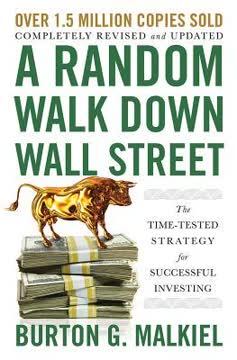Key Takeaways
1. Speculation is a Business: Approach It with Discipline and Patience
"Speculation is far too exciting. Most people who speculate hound the brokerage offices or receive frequent telephone calls, and after the business day they talk markets with friends at all gatherings."
Treat speculation as a serious business. Like any successful enterprise, it requires discipline, patience, and a systematic approach. Many people approach the market with a gambling mentality, constantly seeking action and quick profits. This leads to overtrading, emotional decision-making, and ultimately, losses.
Successful speculators are patient. They understand that there are only a few significant opportunities each year. By waiting for these key moments and avoiding constant trading, you increase your chances of success and reduce unnecessary risks and costs.
Key attributes of successful speculators:
- Disciplined approach to market analysis
- Patience to wait for high-probability setups
- Emotional control to avoid impulsive trades
- Systematic record-keeping and market study
- Treating profits and losses as business outcomes, not personal victories or defeats
2. Timing is Crucial: Wait for Pivotal Points Before Making Moves
"Whenever I have had the patience to wait for the market to arrive at what I call a 'Pivotal Point' before I started to trade, I have always made money in my operations."
Pivotal Points are key price levels that signal potential trend changes or significant moves. These points often occur at previous highs or lows, round numbers, or after a stock has consolidated for a period. By waiting for a stock to reach and react at these levels, you gain valuable information about its likely future direction.
Patience in entering trades is critical. Many traders jump into positions too early, before the market has confirmed its direction. This often leads to being shaken out of good trades or taking unnecessary losses. By waiting for pivotal points and confirmation, you increase your odds of success and reduce the emotional toll of frequent losing trades.
Signs of a potential Pivotal Point:
- Price approaching a previous significant high or low
- Stock reaching a psychologically important round number (e.g., 50, 100, 200)
- Consolidation followed by a breakout on increased volume
- Divergence between price action and technical indicators
- Confluence of multiple support or resistance levels
3. Keep Your Own Records: Develop a Personal Market Analysis Method
"You will be surprised how many new ideas you will formulate in so doing, ideas which no one else could give to you, because they are your discovery, your secret, and you should keep them your secret."
Personal record-keeping is invaluable. By meticulously tracking price movements, volume, and your own trades, you develop a deeper understanding of market behavior. This process helps you recognize patterns and anticipate future moves more accurately.
Develop your own system. While learning from others is important, true mastery comes from creating a method that fits your personality and trading style. Your records become a powerful tool for self-reflection and continuous improvement.
Key elements to include in your market records:
- Price movements and volume data
- Identification of pivotal points and key support/resistance levels
- Notes on market sentiment and news events
- Your own trades, including entry/exit points and rationale
- Post-trade analysis of both winning and losing positions
- Observations on sector rotations and overall market trends
4. Follow the Leaders: Focus on Prominent Stocks and Groups
"If you cannot make money out of the leading active issues, you are not going to make money out of the stock market as a whole."
Concentrate on market leaders. These stocks often provide the clearest trends and most reliable signals. They typically have high liquidity, making them easier to trade with less slippage.
Sector rotation is crucial. Market leadership changes over time. Stay alert to which sectors and stocks are showing the strongest relative strength. This helps you identify where the "smart money" is flowing and increases your chances of catching major moves.
Characteristics of market leaders:
- Consistent earnings growth and strong fundamentals
- High relative strength compared to the broader market
- Increasing institutional ownership
- Positive news flow and analyst upgrades
- Breaking out to new highs on strong volume
Key sectors to monitor (as of Livermore's time):
- Steels
- Motors
- Aircraft stocks
- Mail orders
5. Beware of Inside Information and Tips: Trust Market Action Instead
"Beware of inside information . . . all inside information."
Market action is the ultimate truth. No matter how compelling a tip or inside information may seem, always prioritize what the market is actually doing. Price and volume action reflect all known information and often anticipate future developments.
Tips can be dangerous. Even well-intentioned insiders may not have the full picture or may be biased. Moreover, by the time you receive a tip, the information may already be priced into the stock. Relying on tips can lead to poor timing and emotional decision-making.
Reasons to be skeptical of tips and inside information:
- Information may be incomplete or biased
- Timing is often poor; the move may have already occurred
- Creates emotional attachment to a particular outcome
- Distracts from objective analysis of price and volume action
- May lead to overconfidence and oversized positions
6. Protect Your Capital: Take Profits and Cut Losses Systematically
"Never average losses. Let that thought be written indelibly upon your mind."
Capital preservation is paramount. Without capital, you cannot take advantage of future opportunities. Develop strict rules for taking profits and cutting losses, and adhere to them religiously.
Avoid the temptation to average down. Adding to losing positions often leads to larger losses and emotional decision-making. Instead, focus on cutting losses quickly and re-evaluating the trade.
Key principles for capital preservation:
- Set predetermined stop-loss levels and honor them
- Take partial profits as trades move in your favor
- Never risk more than a small percentage of your capital on any single trade
- Avoid overtrading; quality of trades matters more than quantity
- Regularly withdraw a portion of profits to "lock in" gains
7. Combine Time Element with Price Movements for Accurate Forecasting
"It was not until I began to take into consideration the time element that my records really became useful in helping me to anticipate coming movements of importance."
Time is a crucial factor in market analysis. Price movements alone do not tell the whole story. By considering how long a stock has been consolidating or trending, you can better anticipate potential breakouts or reversals.
Develop a systematic approach. Livermore's method involved tracking prices in specific columns based on the magnitude and direction of moves. This allowed him to visualize patterns and anticipate future movements more accurately.
Key elements of Livermore's time-price analysis:
- Tracking natural rallies and reactions (approximately 6-point moves)
- Identifying pivotal points where trends might change
- Using a "Key Price" based on the combined movement of two leading stocks in a sector
- Differentiating between minor oscillations and significant trend changes
- Recognizing when a stock is "acting right" based on its historical behavior
8. Learn from Both Successes and Failures: Every Trade is a Lesson
"Just admit it and try to profit by it. We all know when we are wrong. The market will tell the speculator when he is wrong, because he is losing money."
Embrace mistakes as learning opportunities. Every trade, whether successful or not, provides valuable information. Analyze your winners to understand what you did right, and dissect your losses to identify areas for improvement.
Maintain a trading journal. Record not just the facts of each trade, but also your thought process and emotional state. This helps you identify patterns in your decision-making and areas where you might be prone to mistakes.
Key questions to ask after each trade:
- Did I follow my trading plan?
- What signals did I see that prompted my entry/exit?
- How did my emotions affect my decision-making?
- Were there any warning signs I missed?
- How can I apply this lesson to future trades?
9. Develop Emotional Control: Fear and Greed are Your Greatest Enemies
"It is dangerous to start spreading out all over the market."
Emotional discipline is crucial. Fear and greed can lead to poor decision-making, such as cutting winners too soon, holding losers too long, or overtrading. Develop strategies to maintain objectivity and stick to your trading plan.
Avoid the urge to always be in the market. Quality of trades is far more important than quantity. Overtrading often stems from impatience or a fear of missing out, leading to suboptimal entries and unnecessary losses.
Strategies for maintaining emotional control:
- Develop and stick to a well-defined trading plan
- Use position sizing to limit risk on any single trade
- Practice visualization and mental rehearsal of various market scenarios
- Take breaks from the market to maintain perspective
- Cultivate interests outside of trading to reduce emotional dependency on results
10. The Livermore Market Key: A Framework for Anticipating Major Moves
"When you are doing nothing, those speculators who feel they must trade day in and day out, are laying the foundation for your next venture. You will reap benefits from their mistakes."
The Livermore Market Key is a systematic approach to identifying major market moves. It combines price action, time elements, and the concept of pivotal points to anticipate significant trends.
Focus on major moves, not minor fluctuations. The key is designed to capture substantial trends, not short-term oscillations. By waiting for clear signals and confirmation, you increase your probability of success and reduce the emotional toll of frequent trading.
Key components of the Livermore Market Key:
- Six-column record-keeping system (Secondary Rally, Natural Rally, Upward Trend, Downward Trend, Natural Reaction, Secondary Reaction)
- Use of different ink colors to visually distinguish trends (black for upward, red for downward)
- Identification of pivotal points through price action and time analysis
- Confirmation of trend changes through key price levels and follow-through
- Combination of individual stock analysis with broader market and sector trends
Last updated:
FAQ
What's "How to Trade In Stocks" about?
- Overview of Speculation: The book is a guide to understanding and mastering the art of stock market speculation, focusing on Jesse Livermore's personal strategies and experiences.
- Livermore's Formula: It introduces Livermore's unique formula for combining the time element and price to predict stock movements.
- Historical Context: Written in 1940, it reflects on Livermore's career and the speculative practices of the early 20th century.
- Practical Advice: The book offers practical advice for both novice and experienced traders on how to approach the stock market as a business.
Why should I read "How to Trade In Stocks"?
- Learn from a Legend: Jesse Livermore is considered one of the greatest stock market speculators, and his insights are invaluable for anyone interested in trading.
- Timeless Strategies: Despite being written decades ago, the strategies and principles discussed are still relevant and applicable today.
- Comprehensive Guide: It covers a wide range of topics from basic trading principles to advanced techniques, making it suitable for traders at all levels.
- Real-Life Examples: Livermore shares personal anecdotes and examples that illustrate the application of his methods in real market scenarios.
What are the key takeaways of "How to Trade In Stocks"?
- Speculation as a Business: Treat stock market speculation as a business, requiring study, discipline, and a systematic approach.
- Importance of Timing: The time element is crucial in trading, and understanding when to enter and exit the market can significantly impact success.
- Avoiding Common Mistakes: Livermore emphasizes avoiding common pitfalls such as averaging down on losing trades and over-trading.
- Pivotal Points: Identifying and acting on pivotal points in stock prices can lead to successful trades and substantial profits.
What is the Livermore Market Key?
- Price Patterns: The Livermore Market Key is a method for identifying price patterns that indicate major market movements.
- Time Element: It incorporates the time element to distinguish between minor fluctuations and significant trends.
- Pivotal Points: The method focuses on pivotal points, which are critical price levels that signal the beginning or end of a trend.
- Record Keeping: Livermore stresses the importance of keeping detailed records to track these patterns and make informed trading decisions.
How does Jesse Livermore define a "Pivotal Point"?
- Critical Price Levels: Pivotal points are specific price levels where a stock's trend is likely to change direction.
- Signal for Action: They serve as signals for traders to either enter or exit a position, depending on the stock's movement relative to these points.
- Confirmation Required: Livermore advises waiting for confirmation of a trend change before acting on a pivotal point.
- Historical Patterns: These points are identified through historical price patterns and require careful analysis and record-keeping.
What are some of the best quotes from "How to Trade In Stocks" and what do they mean?
- "Markets are never wrong—opinions often are." This emphasizes the importance of relying on market data rather than personal biases or opinions.
- "Profits always take care of themselves, but losses never do." Livermore highlights the need to manage losses actively to protect capital.
- "The real money made in speculating has been in commitments in a stock or commodity showing a profit right from the start." This suggests that successful trades often show immediate gains, reinforcing the importance of timing.
- "Never average losses." A warning against the common mistake of buying more of a losing stock in hopes of reducing the average cost.
What is the "Challenge of Speculation" according to Jesse Livermore?
- Fascination and Risk: Speculation is described as a fascinating yet risky endeavor, not suited for the mentally lazy or emotionally unstable.
- Scientific Approach: Livermore advocates for a scientific approach to speculation, involving research, record-keeping, and analysis.
- Patience and Discipline: Success in speculation requires patience, discipline, and the ability to wait for the right opportunities.
- Avoiding Quick Riches: He warns against the allure of quick profits, emphasizing that consistent success comes from treating speculation as a business.
How does Jesse Livermore suggest handling profits and losses?
- Lock in Profits: After a successful trade, Livermore advises taking out a portion of the profits and setting it aside as a reserve.
- Cut Losses Quickly: He stresses the importance of cutting losses quickly to prevent small losses from becoming large ones.
- Avoid Averaging Down: Livermore warns against the practice of averaging down on losing trades, as it can lead to larger losses.
- Psychological Value: Handling profits and losses with discipline has a psychological benefit, helping traders maintain a balanced approach.
What are the "Explanatory Rules" in Livermore's method?
- Recording Prices: Livermore outlines a method for recording stock prices in specific columns to track trends and pivotal points.
- Color-Coding: Prices are recorded in different colors (black for upward trends, red for downward trends) to visually distinguish trends.
- Natural Movements: The rules help identify natural rallies and reactions, which are normal fluctuations within a trend.
- Pivotal Points: The method emphasizes the importance of pivotal points, which are critical for determining the start or end of a trend.
How does Jesse Livermore view "Inside Information"?
- Skeptical of Tips: Livermore is skeptical of inside information and tips, believing they often lead to losses rather than gains.
- Market Action is Key: He emphasizes that the market's action is the most reliable indicator, rather than relying on external information.
- Self-Reliance: Traders should rely on their own analysis and judgment rather than seeking information from others.
- Avoiding Distractions: Inside information can be a distraction from the real task of analyzing market trends and patterns.
What is the significance of "Follow the Leaders" in Livermore's strategy?
- Focus on Leaders: Livermore advises focusing on leading stocks in prominent groups, as they often dictate market trends.
- Avoid Over-Diversification: He warns against spreading investments too thin across many stocks, which can lead to confusion and missed opportunities.
- Market Trends: By following the leaders, traders can better anticipate market trends and make informed decisions.
- Changing Leaders: Livermore notes that market leaders change over time, and traders should adapt to these changes to stay ahead.
What lessons can be learned from Livermore's "Million Dollar Blunder"?
- Importance of Timing: Livermore's blunder highlights the critical importance of timing in trading decisions.
- Patience is Key: The mistake underscores the need for patience and waiting for the right moment to act.
- Avoiding Impulsiveness: Acting impulsively can lead to significant losses, as demonstrated by Livermore's experience.
- Learning from Mistakes: Livermore emphasizes the importance of learning from mistakes and using them to improve future trading strategies.
Review Summary
How To Trade Stock receives mixed reviews, with an average rating of 4.21/5. Readers appreciate Livermore's unique perspective and self-discipline, finding his insights valuable for traders. Many consider it a must-read for aspiring traders. However, some criticize the repetitive content, outdated examples, and questionable relevance to modern markets. Critics also note Livermore's eventual financial losses and tragic end. The book's editing and organization are criticized, with some feeling it promotes software rather than Livermore's original advice. Overall, readers find value in the timeless trading principles but question the applicability of specific techniques.
Similar Books










Download PDF
Download EPUB
.epub digital book format is ideal for reading ebooks on phones, tablets, and e-readers.




